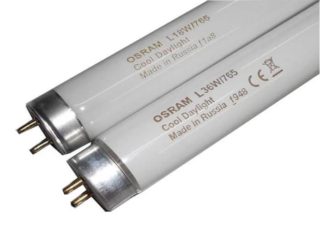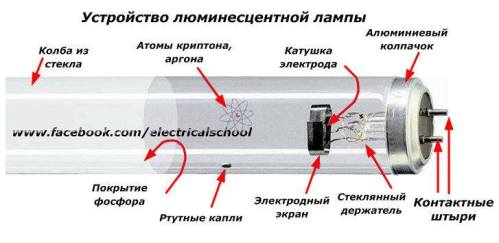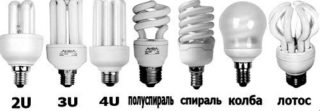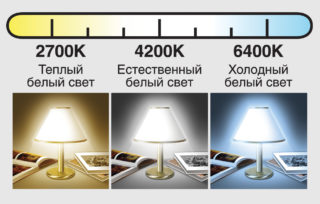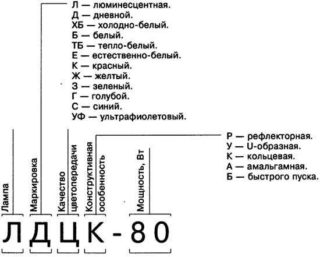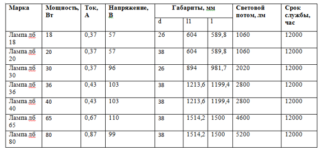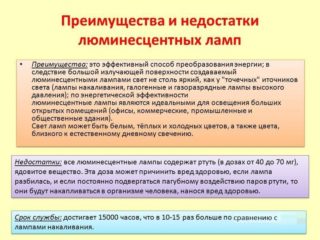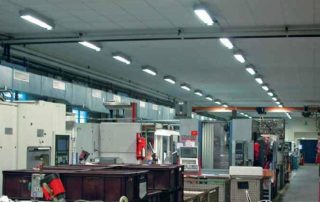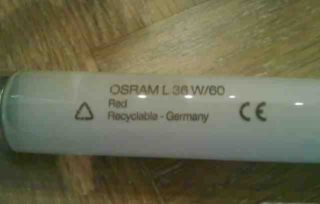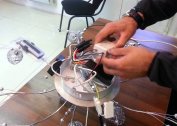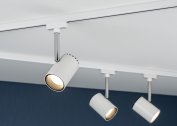Luminescent light sources have taken their place in the field of lighting of houses, apartments and non-residential premises. Even despite the emergence of modern LED lamps, gas-discharge devices are actively used. This is primarily due to energy savings, since fluorescent devices are energy-saving. One of the most popular varieties is a 36 W fluorescent lamp. It differs from other devices in its characteristics and technical features.
Design features and principle of operation
The 36 W lamp is a regular glass tube whose ends are sealed. The inside of the flask is treated with a special tool - a phosphor, which turns the resulting ultraviolet radiation into visible light. The tube is also filled with a mixture of argon and mercury gases. Previously, all air is pumped out of the pipe. Current flows through a tungsten helix, which is coated with oxides to increase reliability. Nickel electrodes are connected to the ends of the spiral.
To light the bulb, you need to apply an electric current. It increases the temperature of the spiral, due to which a discharge appears. The resulting ultraviolet passes through the phosphor and the walls of the flask and at the output turns into visible radiation.
Inside the flask is a mixture of different gases and vapors, which is a plasma. It emits a stream of light in the visible and invisible region of the spectrum. The phosphor converts the invisible radiation into visible, and as a result, the lamp can illuminate a certain area.
Thanks to this design and advanced materials, the bulb will consume less power than conventional luminaires. If compared with an incandescent lamp, the amount of energy required will decrease by several times.
Types of Fluorescent Tubes
Any fluorescent devices can be divided into two groups:
- General purpose lamps. These include fixtures with a power of 15 to 80 watts.
- Special purpose. Such devices are up to 15 watts and over 80 watts. They are called low-power and super-powerful, respectively.
General-purpose lamps give natural light.
Also, devices can be divided according to a number of technical indicators:
- By light discharge: arc and smoldering.
- By radiation: with natural light, ultraviolet and with different colors.
- The shape of the flask: linear tubes and curly models.
- Along the length of the tube.
- According to the used base: 14 mm and 27 mm.
- By the distribution of light flux: directional and non-directional.
Color Temperature Classification:
- 2700-3400 K. These are warm shades. They have a calming and relaxing effect, so they are often placed in the bedrooms.
- 3400-5600 K. Give natural radiation. Applicable in living rooms, in the kitchen and other types of premises.
- 5600-6400 K. Cold tones. They increase tone and performance, therefore they are used in offices.
A 36 W fluorescent source is an analogue of a 40 W device. This is due to the fact that modern technologies allow the use of higher quality, reliable and modern materials.
Energy-saving devices use a high-quality phosphor layer and an improved design of the electrode block. Due to all these features, lower power fluorescent bulbs have a large luminous effective flux.It is important to note a decrease in tube diameter by 1.6 times.
Marking of light sources
The 36 W fluorescent lamp has a simple alphanumeric marking. For example, a 36w daylight lamp with the abbreviation LB-36 is deciphered as follows:
- L is the lamp.
- B - white color.
- 36 - power, watts.
There are also 36W fluorescent lamps with a different marking:
- Ltb. Warm white light. They have a barely noticeable pink tint.
- Ld. Close to daylight.
- LDC - fluorescent lamps with different colors.
- LHB - cold white.
The given marking is used in Russian products. Foreign designation is different. It consists of three numbers and English words indicating the type of glow. Labeling may vary by different foreign manufacturers.
LB products are the most efficient in terms of light output compared to other devices of the same power.
Specifications
A 36 watt lamp has the following characteristics:
- radiation brightness of 6-11 cd / sq.m;
- ripple factor 23%;
- brightness and power increase along with an increase in the rated voltage;
- service life from 4800 hours, the average value is 12000 hours;
- cap G13;
- bulb diameter 26 mm;
- length of most 12 cm;
- rated voltage 103 V.
The data shown are average values. They may vary by different manufacturers and under specific operating conditions. The service life can be significantly reduced due to frequent on and off or high humidity in the room and low temperature. Therefore, it is important to choose the right location for the light source.
Advantages and disadvantages
Luminescent devices are inferior to LEDs, but are still often used for backlighting. This is due to the positive qualities of a 36 W fluorescent bulb:
- small dimensions and weight;
- wide scope of application;
- saving;
- large coverage area;
- extended spectrum of luminescence;
- long service life;
- good coefficient of performance;
- the presence of analogues for various purposes and colors.
Disadvantages of light bulbs also have:
- the presence of harmful substances in the device;
- complexity of disposal;
- harm to human health and eyes;
- throttle required to start;
- increase in value;
- long launch;
- Reduced service life due to frequent switching on and off.
The devices are actively used and replace obsolete incandescent lamps and halogen devices.
Fields of application
Fluorescent lamps have an extensive range of uses. They can create all types of lighting in residential premises, offices, fill production rooms with light, create illuminations.
The devices have found their application in medicine. Using special fillers, bactericidal and ultraviolet lamps can be created. They are used to clean the room from bacteria and germs. Also, lamps can be placed in stores, warehouses and enterprises with the aim of disinfecting the premises.
The ability to create sources of different colors led to the use of fluorescent bulbs in the field of entertainment, show business, and advertising.
Selection recommendations
Lamps are selected for a specific type of lamp. This obliges the buyer to pay attention to its characteristics. Especially carefully choose fluorescent lamps. For example, the Russian lamp LB 36 has a length of 1200 mm and is suitable for installation in the corresponding device. A 35 W device similar in power from the German company OSRAM has a different length - 1449 mm. The length of the tube must be considered when buying.
Attention is paid to the diameter of the flask. The standard is 16 mm, but devices for 12 mm, 25 mm and other sizes can be found. The luminous flux directly depends on the diameter.In luminaires, you can use a tube with the same base (G13) with a smaller diameter, with a larger one - it is impossible.
Fluorescent lamps have ripples that have a negative effect on health. To reduce the negative impact, you should give preference to high-quality, expensive and tested devices purchased in a professional store. A lamp of unknown production is made of low-quality components, and this directly affects the flicker.
